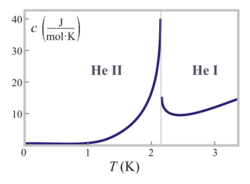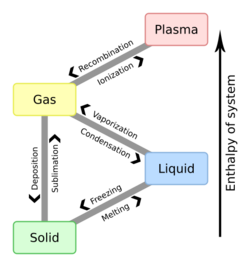Physics:Lambda point
The lambda point is the temperature at which normal fluid helium (helium I) makes the transition to superfluid helium II (approximately 2.17 K at 1 atmosphere). The lowest pressure at which He-I and He-II can coexist is the vapor−He-I−He-II triple point at 2.1768 K (−270.9732 °C) and 5.0418 kPa (0.049759 atm), which is the "saturated vapor pressure" at that temperature (pure helium gas in thermal equilibrium over the liquid surface, in a hermetic container).[1] The highest pressure at which He-I and He-II can coexist is the bcc−He-I−He-II triple point with a helium solid at 1.762 K (−271.388 °C), 29.725 atm (3,011.9 kPa).[2]
The point's name derives from the graph (pictured) that results from plotting the specific heat capacity as a function of temperature (for a given pressure in the above range, in the example shown, at 1 atmosphere), which resembles the Greek letter lambda [math]\displaystyle{ \lambda }[/math]. The specific heat capacity has a sharp peak as the temperature approaches the lambda point. The tip of the peak is so sharp that a critical exponent characterizing the divergence of the heat capacity can be measured precisely only in zero gravity, to provide a uniform density over a substantial volume of fluid. Hence the heat capacity was measured within 2 nK below the transition in an experiment included in a Space Shuttle payload in 1992.[3]
| Unsolved problem in physics: Explain the discrepancy between the experimental and theoretical determinations of the heat capacity critical exponent α for the superfluid transition in helium-4.[4]
(more unsolved problems in physics)
|
Although the heat capacity has a peak, it does not tend towards infinity (contrary to what the graph may suggest), but has finite limiting values when approaching the transition from above and below.[3] The behavior of the heat capacity near the peak is described by the formula [math]\displaystyle{ C\approx A_\pm t^{-\alpha}+B_\pm }[/math] where [math]\displaystyle{ t=|1-T/T_c| }[/math] is the reduced temperature, [math]\displaystyle{ T_c }[/math] is the Lambda point temperature, [math]\displaystyle{ A_\pm,B_\pm }[/math] are constants (different above and below the transition temperature), and α is the critical exponent: [math]\displaystyle{ \alpha=-0.0127(3) }[/math].[3][5] Since this exponent is negative for the superfluid transition, specific heat remains finite.[6]
The quoted experimental value of α is in a significant disagreement[7][4] with the most precise theoretical determinations[8][9][10] coming from high temperature expansion techniques, Monte Carlo methods and the conformal bootstrap.
See also
References
- ↑ Donnelly, Russell J.; Barenghi, Carlo F. (1998). "The Observed Properties of Liquid Helium at the Saturated Vapor Pressure". Journal of Physical and Chemical Reference Data 27 (6): 1217–1274. doi:10.1063/1.556028. Bibcode: 1998JPCRD..27.1217D.
- ↑ Hoffer, J. K.; Gardner, W. R.; Waterfield, C. G.; Phillips, N. E. (April 1976). "Thermodynamic properties of 4He. II. The bcc phase and the P-T and VT phase diagrams below 2 K". Journal of Low Temperature Physics 23 (1): 63–102. doi:10.1007/BF00117245. Bibcode: 1976JLTP...23...63H.
- ↑ 3.0 3.1 3.2 Lipa, J.A.; Swanson, D. R.; Nissen, J. A.; Chui, T. C. P.; Israelsson, U. E. (1996). "Heat Capacity and Thermal Relaxation of Bulk Helium very near the Lambda Point". Physical Review Letters 76 (6): 944–7. doi:10.1103/PhysRevLett.76.944. PMID 10061591. Bibcode: 1996PhRvL..76..944L.
- ↑ 4.0 4.1 Rychkov, Slava (2020-01-31). "Conformal bootstrap and the λ-point specific heat experimental anomaly" (in en). Journal Club for Condensed Matter Physics. doi:10.36471/JCCM_January_2020_02. https://www.condmatjclub.org/?p=4037.
- ↑ Lipa, J. A.; Nissen, J. A.; Stricker, D. A.; Swanson, D. R.; Chui, T. C. P. (2003-11-14). "Specific heat of liquid helium in zero gravity very near the lambda point". Physical Review B 68 (17): 174518. doi:10.1103/PhysRevB.68.174518. Bibcode: 2003PhRvB..68q4518L.
- ↑ For other phase transitions [math]\displaystyle{ \alpha }[/math] may be negative (e.g. [math]\displaystyle{ \alpha\approx+0.1 }[/math] for the liquid-vapor critical point which has Ising critical exponents). For those phase transitions specific heat does tend to infinity.
- ↑ Vicari, Ettore (2008-03-21). "Critical phenomena and renormalization-group flow of multi-parameter Phi4 theories" (in en). Proceedings of the XXV International Symposium on Lattice Field Theory — PoS(LATTICE 2007) (Regensburg, Germany: Sissa Medialab) 42: 023. doi:10.22323/1.042.0023.
- ↑ Campostrini, Massimo; Hasenbusch, Martin; Pelissetto, Andrea; Vicari, Ettore (2006-10-06). "Theoretical estimates of the critical exponents of the superfluid transition in $^{4}\mathrm{He}$ by lattice methods". Physical Review B 74 (14): 144506. doi:10.1103/PhysRevB.74.144506.
- ↑ Hasenbusch, Martin (2019-12-26). "Monte Carlo study of an improved clock model in three dimensions". Physical Review B 100 (22): 224517. doi:10.1103/PhysRevB.100.224517. ISSN 2469-9950. Bibcode: 2019PhRvB.100v4517H.
- ↑ Chester, Shai M.; Landry, Walter; Liu, Junyu; Poland, David; Simmons-Duffin, David; Su, Ning; Vichi, Alessandro (2020). "Carving out OPE space and precise O(2) model critical exponents". Journal of High Energy Physics 2020 (6): 142. doi:10.1007/JHEP06(2020)142. Bibcode: 2020JHEP...06..142C.
External links
 |



